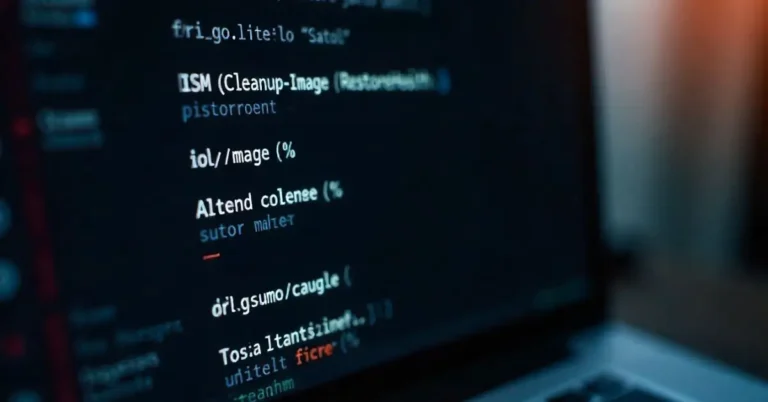In today’s digital world, system stability is key to maintaining productivity and preventing disruptions. If your Windows PC starts running slowly, crashing randomly, or showing strange error messages, then learning how to use the DISM restore health command could save you time and frustration. This built-in command-line tool is designed to repair Windows image files, ensuring your system functions correctly without needing extra software.
The DISM restore health command is part of the Deployment Imaging Servicing and Management (DISM) toolkit, a feature integrated into modern versions of Windows. This command checks the system image for corruption and repairs any issues it finds by pulling clean files from Windows Update or a local image. It’s one of the most effective ways to fix operating system problems when other methods fail.
What Is DISM Restore Health?
Introduction to DISM
DISM stands for Deployment Imaging Servicing and Management. It is a command-line tool available in Windows 8, 10, 11, and Server editions. DISM is mainly used by IT professionals to repair Windows images, mount ISO files, or manage drivers and features.
What “Restore Health” Means in Windows
The restore health function of DISM is used to scan the operating system’s core files and fix any corruption by downloading correct versions from Microsoft’s servers or a local source. It essentially restores the Windows system image back to a healthy, working state.
When Should You Use DISM Restore Health?
Symptoms That Suggest You Need DISM
You should consider using DISM restore health if you experience:
- Frequent system crashes or blue screens
- Windows updates that fail repeatedly
- Missing or corrupted system files
- Sluggish system performance
- Inability to launch programs or settings
Common Triggers and Errors It Fixes
DISM is effective against:
- Update errors like 0x800f081f
- Windows Resource Protection issues
- Problems that System File Checker (SFC) can’t fix
How to Run DISM Restore Health Command
Step-by-Step Instructions (with CMD)
- Press
Win + Xand choose Command Prompt (Admin) or Windows Terminal (Admin). - Type the following command:
DISM /Online /Cleanup-Image /RestoreHealth - Press Enter.
- Wait for the process to complete (can take 10–30 minutes).
- Reboot your computer.
Running DISM in Safe Mode or via Bootable Media
If Windows won’t boot properly, you can:
- Use Safe Mode with Networking.
- Boot from a Windows installation USB and open Command Prompt.
- Run the DISM command from there.
DISM vs SFC vs CHKDSK
What’s the Difference?
| Tool | Purpose | Works On |
|---|---|---|
| DISM | Repairs Windows image corruption | System files |
| SFC | Scans and fixes protected system files | Running OS |
| CHKDSK | Checks disk errors and bad sectors | Physical drives |
When to Use Each Tool?
- Start with SFC /scannow.
- If errors persist, run DISM restore health.
- If you suspect disk issues, use CHKDSK.
Pros and Cons of Using DISM Restore Health
Pros:
- Deep-level repair of system files
- Integrated into Windows
- Fixes update errors
- Doesn’t require extra software
Cons:
- Requires admin privileges
- Can take time
- May need an internet connection
Comparison Table of System Repair Tools
| Feature | DISM Restore Health | SFC | CHKDSK | Windows Recovery | 3rd-Party Tools |
|---|---|---|---|---|---|
| Cost | Free | Free | Free | Free | Varies |
| Ease of Use | Moderate | Easy | Easy | Easy | Easy |
| Repair Level | Deep Image Repair | File | Disk | OS Restore | Varies |
| Online Help | Extensive | High | High | Moderate | Depends |
| Offline Use | Yes (with image) | No | Yes | Yes | Yes |
Best Practices Before and After Running DISM Restore Health
Precautions and Backups
Before running the command:
- Save your work
- Back up critical files
- Ensure you have internet or a clean image file
Post-scan Steps and Reboot
After DISM completes:
- Run SFC /scannow for full repair
- Reboot your system
- Check update and app performance
Common Errors During DISM Restore Health & Fixes
DISM Error 0x800f081f
This often means required files couldn’t be found.
Fix: Specify a repair source:
DISM /Online /Cleanup-Image /RestoreHealth /Source:D:\sources\install.wim /LimitAccess
DISM Stuck at 20%, 40%, or 62%
This is common.
Fix: Be patient; unless there’s an error message, don’t close it. It can resume progress after minutes.
Expert Tips to Optimize Your System Health
Scheduled Scans
Use Task Scheduler to automate DISM every month. Prevent problems before they appear.
Combine DISM with Other Maintenance Routines
Pair DISM with:
- SFC for surface-level repairs
- Disk Cleanup to remove junk
- Windows Update Troubleshooter
Conclusion
Using the DISM restore health command is one of the smartest ways to protect and repair your Windows system. Whether you’re fixing update issues, system slowdowns, or random crashes, this powerful utility gives you control and confidence. Keep it in your maintenance toolkit for long-term system reliability.
FAQ’s
What is DISM restore health used for?
It repairs the Windows system image to resolve corruption and other serious OS issues.
Can I run DISM restore health without internet?
Yes, but you need to specify a local image source using the /Source: parameter.
Does DISM delete my files?
No, it only repairs the Windows image. Your files and apps remain untouched.
How long does DISM restore health take?
Anywhere from 10 to 30 minutes depending on your system and internet speed.
What to do after running DISM?
Run SFC /scannow to fix any remaining issues and restart your PC.
Can I use DISM on Windows 11?
Yes, DISM is fully compatible with Windows 11.

